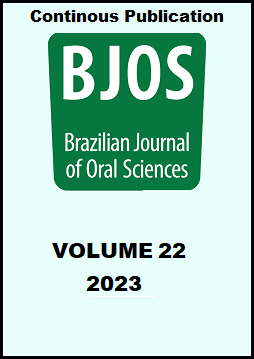Abstract
Aim: Dental number anomalies are a group of congenital developmental disorders divided into two groups supernumerary and missing teeth. This study was conducted to investigate the prevalence of numeric dental anomalies using panoramic images in patients referred to the Hamadan Dental Faculty. Methods: In this cross-sectional study, 2,197 panoramic radiographs of patients aged 6-49 years were evaluated. These anomalies are divided into two groups: 1) Supernumerary teeth, including Mesiodens, Distodens, and Peridens, and 2) Missing teeth, including Hypodontia, Oligodontia, and Anodontia. A Chi-square test was performed to assess the relationship between the anomalies. Data analysis was performed using SPSS 16, in which P-value < 0.05 was considered the statistical significance level. Results: Of 736 males (32.2%) and 1548 females (67.8%) in this study, 32 (4.3%) and 55 cases (3.8%) had supernumerary teeth, respectively. The prevalence of supernumerary teeth was 0.3%, 0.5%, and 0.6% in males and 0.2%, 1% and 1.2% in females for mesiodens, distodens, and peridens, respectively. Also, 243 males (10.6%) and 655 females (28.6%) had missing teeth anomalies. Hypodontia in the maxilla was the most common anomaly in both genders, while mesiodens was the least common. Conclusion: Hypodontia was the most common anomaly, followed by peridens; the least common anomaly was mesiodens. The prevalence of supernumerary teeth was greater in males, though the difference was not statistically significant. In comparison, females had a greater prevalence of missing teeth.
References
White SC, Pharoah MJ. Oral radiology - e-book: principles and interpretation. Elsevier Health Sciences; 2014.
Yassin SM. Prevalence and distribution of selected dental anomalies among saudi children in Abha, Saudi Arabia. J Clin Exp Dent. 2016 Dec;8(5):e485-90. doi: 10.4317/jced.52870.
Amini F, Rakhshan V, Babaei P. Prevalence and pattern of hypodontia in the permanent dentition of 3374 Iranian orthodontic patients. Dent Res J (Isfahan). 2012 May;9(3):245-50.
Bäckman B, Wahlin YB. Variations in number and morphology of permanent teeth in 7-year-old Swedish children. Int J Paediatr Dent. 2001 Jan;11(1):11-7. doi: 10.1046/j.1365-263x.2001.00205.x.
Chung CJ, Han JH, Kim KH. The pattern and prevalence of hypodontia in Koreans. Oral Dis. 2008 Oct;14(7):620-5. doi: 10.1111/j.1601-0825.2007.01434.x.
Shokri A, Poorolajal J, Khajeh S, Faramarzi F, Kahnamoui HM. Prevalence of dental anomalies among 7- to 35-year-old people in Hamadan, Iran in 2012-2013 as observed using panoramic radiographs. Imaging Sci Dent. 2014 Mar;44(1):7-13. doi: 10.5624/isd.2014.44.1.7.
Rakhshan V. Congenitally missing teeth (hypodontia): A review of the literature concerning the etiology, prevalence, risk factors, patterns and treatment. Dent Res J (Isfahan). 2015 Jan-Feb;12(1):1-13. doi: 10.4103/1735-3327.150286.
Káldy A, Balaton G. [Severe hypodontia in permanent dentition. Orthodontic treatment of oligodontia in children]. Fogorv Sz. 2012 Dec;105(4):161-5. Hungarian.
Korbendau J-M, Patti A. Clinical success in surgical and orthodontic treatment of impacted teeth: Quintessence International Editeur; 2019.
Trakinienė G, Ryliškytė M, Kiaušaitė A. Prevalence of teeth number anomalies in orthodontic patients. Stomatologija. 2013;15(2):47-53.
Deihimi P. Tooth pathology and odontogenic lesions. Isfahan: Kankash CO; 2006.
Saberi EA, Ebrahimipour S. Evaluation of developmental dental anomalies in digital panoramic radiographs in Southeast Iranian Population. J Int Soc Prev Community Dent. 2016 Jul-Aug;6(4):291-5. doi: 10.4103/2231-0762.186804.
Bilge NH, Yeşiltepe S, Törenek Ağırman K, Çağlayan F, Bilge OM. Investigation of prevalence of dental anomalies by using digital panoramic radiographs. Folia Morphol (Warsz). 2018;77(2):323-8. doi: 10.5603/FM.a2017.0087.
Montasser MA, Taha M. Prevalence and distribution of dental anomalies in orthodontic patients. Orthodontics (Chic.). 2012;13(1):52-9.
Kumar D, Datana S, Kadu A, Agarwal SS, Bhandari S. The prevalence of dental anomalies among the Maharashtrian population: a radiographic study. J Dent Def Sect. 2020 Jan;14(1):11. doi : 10.4103/JODD.JODD_5_19.
Gupta SK, Saxena P, Jain S, Jain D. Prevalence and distribution of selected developmental dental anomalies in an Indian population. J Oral Sci. 2011 Jun;53(2):231-8. doi: 10.2334/josnusd.53.231.
Osuji O, Hardie J. Prevalence of dental anomalies. Saudi Dent J. 2002;14(1):11-4.
Açikgöz A, Açikgöz G, Tunga U, Otan F. Characteristics and prevalence of non-syndrome multiple supernumerary teeth: a retrospective study. Dentomaxillofac Radiol. 2006 May;35(3):185-90. doi: 10.1259/dmfr/21956432.
Anthonappa RP, King NM, Rabie AB. Diagnostic tools used to predict the prevalence of supernumerary teeth: a meta-analysis. Dentomaxillofac Radiol. 2012 Sep;41(6):444-9. doi: 10.1259/dmfr/19442214.
Aktan AM, Kara IM, Şener İ, Bereket C, Ay S, Çiftçi ME. Radiographic study of tooth agenesis in the Turkish population. Oral Radiol. 2010 Dec;26(2):95-100.
Haghanifar S, Moudi E, Abesi F, Kheirkhah F, Arbabzadegan N, Bijani A. Radiographic Evaluation of Dental Anomaly Prevalence in a Selected Iranian Population. J Dent (Shiraz). 2019 Jun;20(2):90-4. doi: 10.30476/DENTJODS.2019.44929.
Bayar GR, Ortakoglu K, Sencimen M. Multiple impacted teeth: report of 3 cases. Eur J Dent. 2008 Jan;2(1):73-8.
Behr M, Proff P, Leitzmann M, Pretzel M, Handel G, Schmalz G, et al. Survey of congenitally missing teeth in orthodontic patients in Eastern Bavaria. Eur J Orthod. 2011 Feb;33(1):32-6. doi: 10.1093/ejo/cjq021.
Kilinç G, Akkemik OK, Candan U, Evcil MS, Ellidokuz H. Agenesis of third molars among turkish children between the ages of 12 and 18 years: a retrospective radiographic study. J Clin Pediatr Dent. 2017;41(3):243-7. doi: 10.17796/1053-4628-41.3.243.
Soni HK, Joshi M, Desai H, Vasavada M. An orthopantomographic study of prevalence of hypodontia and hyperdontia in permanent dentition in Vadodara, Gujarat. J Dent Res. 2018 Jul-Aug;29(4):529-33. doi: 10.4103/ijdr.IJDR_215_16.
Yusof W. Non-syndrome multiple supernumerary teeth: literature review. J Can Dent Assoc. 1990 Feb;56(2):147-9.
Sheikhi M, Sadeghi MA, Ghorbanizadeh S. Prevalence of congenitally missing permanent teeth in Iran. Dent Res J (Isfahan). 2012 Dec;9(Suppl 1):105-11.
Ayala Sola R, Ayala Sola P, De La Cruz Pérez J, Nieto Sánchez I, Díaz Renovales I. Prevalence of hypodontia in a sample of spanish dental patients. Acta stomatol Croat. Acta Stomatol Croat. 2018 Mar;52(1):18-23. doi: 10.15644/asc52/1/3.
Gracco AL, Zanatta S, Valvecchi FF, Bignotti D, Perri A, Baciliero F. Prevalence of dental agenesis in a sample of Italian orthodontic patients: an epidemiological study. Prog orthod. 2017 Oct 16;18(1):33. doi: 10.1186/s40510-017-0186-9.

This work is licensed under a Creative Commons Attribution 4.0 International License.
Copyright (c) 2022 Abbas Shokri, Anahita Bakhshaei, Leili Tapak, Parisa Shokouhi


